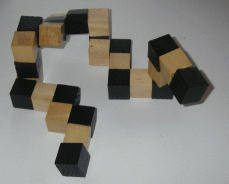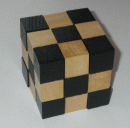| ENG RUS | Timus Online Judge |
NEERC 2008, Eastern subregion quarterfinals
Contest is over
I. Cube SnakeTime limit: 2.0 second Memory limit: 64 MB  Before the Quarterfinal contest, a team of programmers were given several
puzzles from the online shop  A snake consists of 27 small cubes that are strung, as beads,
onto a strong thread. The thread is fixed inside the end cubes and goes through
each of the remaining cubes from the center of one face to the center of another face.
Though some of the cubes the thread goes straight, connecting opposite faces,
and inside other cubes it turns, going through the centers of adjacent faces.
The thread doesn't allow the cubes to move apart, but makes it possible to rotate
a part of the cubes with respect to the other part. It is required to fold the
snake into a InputThe only input line contains 27 letters describing the snake as a sequence of
“straight” (denoted by the letter “F”) and
“turning” (denoted by the letter “T”) small cubes.
The end cubes are considered as straight.
OutputIf you can make a cube from the given snake, output
26 letters describing the sequence of folding. Each letter shows the
position of a small cube (starting from the second one) with respect to the
preceding small cube. This position can be at the front (“F”),
behind (“B”), on the right (“R”), on the left
(“L”), on top (“U”), or below (“D”).
If it is impossible to make a cube from the given snake, output
“IMPOSSIBLE”.
Samples
Problem Author: Stanislav Vasilyev (prepared by Sergey Pupyrev) Problem Source: NEERC 2008, Eastern subregion quarterfinals |
